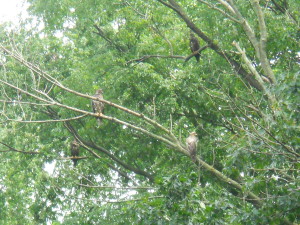By Michael Carson
Environmental & Plant Biology internship at Old Woman Creek National Estuarine Reserve, Huron, OH
Finally I have started what I came here to do initially, count plants in a wetland.
That’s not to say that I haven’t been having a blast in the last 3 weeks, or that nothing has been happening. I have helped my boss I guess is what you would call her, monitoring macro invertebrates in two of the local streams here in Huron, Ohio.
What I learned (other than many names of fresh water invertebrates that I previously did not know) is that depending on the type of invertebrates we are finding in the water is an indicator of the water quality in the stream. For example things like crayfish and leeches are typically indicators of poor water health (if you are only finding crayfish and leeches, they can be in healthy water, also), while things like damselfly and dragonfly larvae will only be found in healthier waters.
I also have helped create a “floating wetland,” which is a floating island that you can plant native plants on, and then put out into a pond, fountain, etc. in a public space to make it more aesthetically pleasing.
I have also begun to make a restoration plan for a small marsh area in the Old Woman’s Creek estuary that the land manager and other employees have been wanting to rid of the invasive Phragmites australis and then restore with native plants. I am really excited with this project because initially it wasn’t in my list of things they wanted me to do over this summer, but once I mentioned that I am interested in maybe doing restoration work after college, they told me that I could design and implement the project myself. So far we have only sprayed the P. australis and are waiting for that to die so we can clear out all the detritus but I am very excited to see how it turns out by the time I leave in August.



















Comments